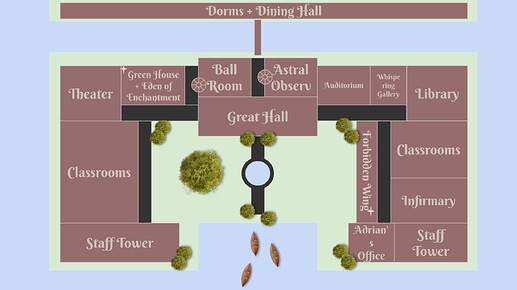Since group 2 finished first and they figured out here they need to go next, there were the first group to get to the entrance hall.
Followed by group 1 and group 3 at the same time (even tho group 1 was the last group in part 2, group 3 had trouble deciding where they have to go, side eye Oggy sorry).
Group 4 is the last group to get to the entrance hall since they couldn’t decide if they need to go there or to the auditorium.
1. Dead parents society (and Michelle)
In the library Professor Vlahos offers Team 1 a choice of ancient artifacts tied to the history of the academy’s books. One of these objects holds the key to their next destination. What do you go for first?
You all went for a quill that never stops writing, while it is one interesting object that could show you more than you could imagine, it wasn’t the right choice.
Try again.
Maybe teaming up with Hayes was a bad idea :(((
- An Old Bookstand: This bookstand has been used to display the most ancient tomes in the library. Perhaps it hides a secret compartment with a clue?
- The Unfinished Scroll: At first look it’s a simple scroll but could there be more to it if you recites a specific spell?
4. TAA
At the observatory Professor Somerset offers Team 4 several celestial artifacts, hinting that one will help them see their path forward.
You were indecisive. Try again.
- An Ancient Celestial Globe: The professor presents a beautifully intricate celestial globe. Should Team 4 try to rotate it in a specific sequence?
- The Telescope of Ages: A telescope that has been used for hundreds of years to study the skies might be able to reveal something important if they point it at the right constellation.
I was paying attention to who voted first, when blah blah sooooo…:
Group 3 was the first group to pick the right objects, with Oggy suggesting they go for a plant with singing leaves. Listening closely and carefully, the plant revealed a hidden spell with the final clue for their next location.
Group 2 was second, Nessa picking a mysterious recipe book. Upon closer inspection, a page reveals a hidden spell with the final clue for their next location.
Group 3 and 2 are tied!!! This next poll might decide a winner?
Both groups were instructed to go the forbidden wing.
2. Adrians Favs
Team 2 hurried through the hallways of Ninth House, excitement and tension building as they approached the forbidden section of the school. The air around them felt heavy and even the walls seemed to close in as they got closer to their final location. Every student had heard rumors about this eerie part of the building—whispers of locked doors that hadn’t been opened in decades, rooms filled with ancient secrets, and spells forgotten by time.
At last, they arrived at the entrance. The door to the Forbidden Wing was large, covered in dust, with intricate carvings of magical symbols. Team 3 was right behind them, got in time to witness the door slowly opening as if it had been expecting them, revealing a long corridor lined with doors.
They knew what had to be done. They just learned a spell to unlock one of these mysterious doors. But which one?
- Door 1
- Door 2
- Door 3
- Door 4
3. Rens fan club
The path leading to this part of the school felt far longer than it had ever seemed before. The air had grown colder, and the dim lighting gave the impression that they were no longer in a school but in a place forgotten by time.
Everyone knew the stories. The Forbidden Wing was sealed off for good reason. Yet here they were, standing at the threshold, holding a plant with singing leaves. It had given them a clue - an ancient spell they were to cast. But first, they had to figure out which door would open.
- Door 1
- Door 2
- Door 3
- Door 4
@NinthHouse
![]()






